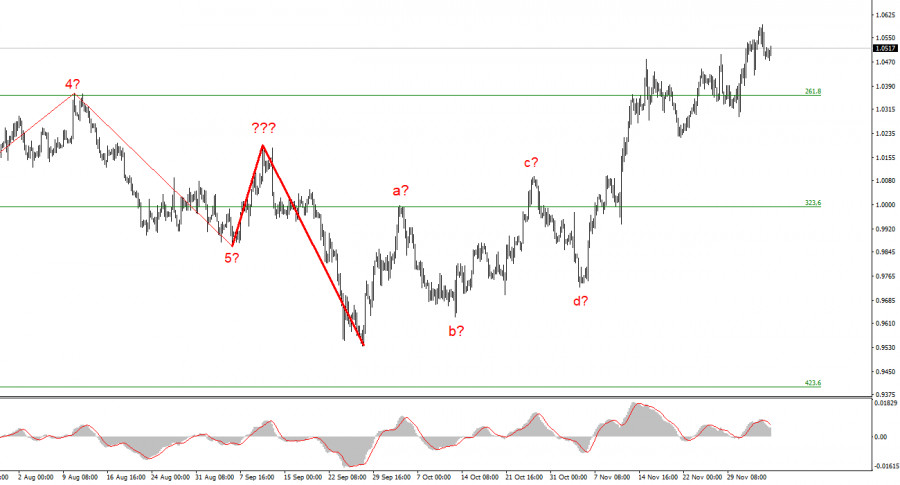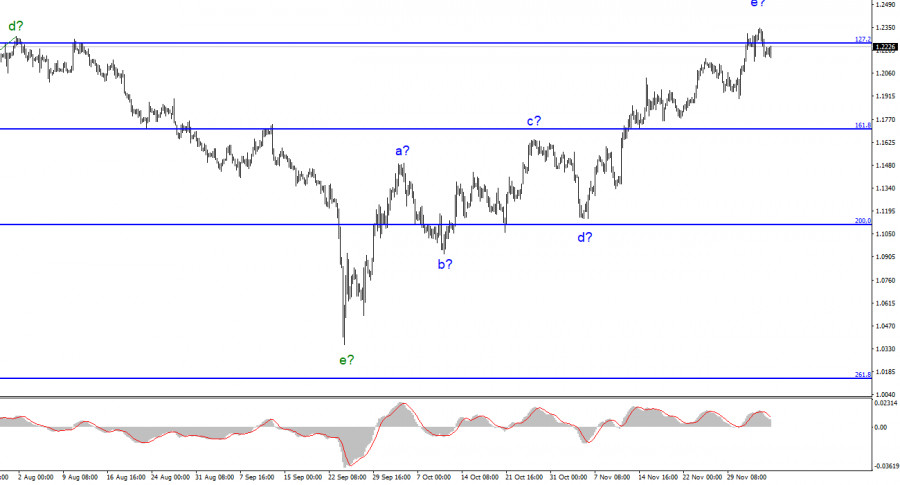
Soon all three major central banks will announce their rate decisions. However, I'm not particularly interested in speculation about the size of rate hikes by central banks. Recently, there have been not so many economic reports or crucial events. A few weeks ago, traders widely discussed the US mid-term election, political changes in the UK, the UK budget deficit, etc. Now, markets are in a lull. The economic calendar includes only several economic reports. As a rule, there are 5 really important reports which are published every month. All the others are less significant. Although traders also take them into account, they do not affect the wave marking. Currently, there are no crucial speeches, events, or macro stats.
However, traders are looking forward to the upcoming reports and events. Usually, in such situations, the construction of corrective waves begins. Now, I do not see any of them. Both instruments continue to be hovering near their highs. Demand for them remains buoyant although over the past few weeks there have been enough reasons to increase long positions on the US currency. What is more, analysts are now mulling over the likelihood of a recession in the United States.
The Financial Times conducted a survey, showing that many economists anticipate a mild recession in the US. Hence, 85% of economists polled project a recession by next year. Unemployment is likely to rise to 5.5%-6.5%. The majority of participating analysts expect the Fed to raise its benchmark policy rate by 50 basis points in December. The US economy may shrink by 1%. Shortly after, it will grow again. Notably, Jerome Powell has repeatedly stated that a strong labor market and minimal unemployment are hopeful signs against a recession. It appears Powell is right as the latest NFP report turned out to be upbeat. The unemployment rate remained at 3.7%, not far from a 5-decade low. The American economy expanded in the third quarter. It also climbed considerably in annual terms. Thus, there is no reason to panic.

Jerome Powell also believes that the "soft landing" is still possible. However, most of the economists polled by the Financial Times are not so optimistic. "A soft landing is extremely difficult and it almost never happens in history," Giorgio Primiceri, a professor at Northwestern University who participated in the survey, said. If the forecasts are correct, a recession in the US will be short-lived. However, if the Fed raises the interest rate to 5-5.5%, it could trigger a strong and long recession. In the UK, a recession may last 2 years. Chancellor of the Exchequer Jeremy Hunt and Bank of England Governor Andrew Bailey admitted such a possibility. In my opinion, if this scenario comes true, it will be extremely bullish for the US dollar. Now, it is unable to resume an uptrend.
Taking into account all these factors, I assume that the construction of the upward trend section has extended to five waves. It is completed or nearing its completion. It is recommended to open short positions with target levels located near 0.9994, which coincides with the Fibonacci correction level of 323.6%. The upward section of the trend may become more complicated and take a more extended form. The probability of this scenario is rather high.

The wave markup of the pound/dollar pair suggests the construction of a new downward trend wave. I would advise you to postpone long positions as the wave markup points at the construction of a downward trend section. It is better to sell the instrument at 1.1707, which coincides with the Fibonacci correction level of 161.8%. However, the e wave can take an even more extended form.